St Kilda is a small group of islands of volcanic origin, 40 miles west of the Outer Hebrides, off the west coast of Scotland. The islands were inhabited until the early 1930s. I signed up for a two week sailing cruise, out of Dunstaffnage, a few miles north of Oban, from 29th May to 12th June 2010.
Sailing cruises do not have quite the same connotation as cruising in larger boats. You are one of the crew, and this is a learning experience as well as a way of visiting out of the way places. I was taking my Coastal Skipper practical course on this trip, as were two of the other crew members.

Day 1, Saturday. Arrived at Dunstaffnage in the early afternoon. I took a look at the castle, before going to the base to be introduced to the boat, Ocean Lord, to the skipper, Brian, and to the other crew members, Phil, John and Mike. Ocean Lord is a 41 ft Westerly, with plenty of room for five. After loading up with supplies, we left on a short trip to Loch Aline, in the Sound of Mull. We were motoring, as there was no wind to speak of. We anchored there for the night.
Day 2, Sunday. We beat up the Sound of Mull against a north westerly. We berthed in Tobermory for a short while to pick up a few extra supplies (including a can opener!) and got in some boat handling practice. Then headed out, a bit further up the sound to Kilchoan Bay, on the other (mainland) side of the sound. We tried to anchor, but the holding wasn’t good, so we settled for one of the mooring buoys. We inflated the dingy for the first time to head for shore, and walk over to the local hostelry for a beer or two.
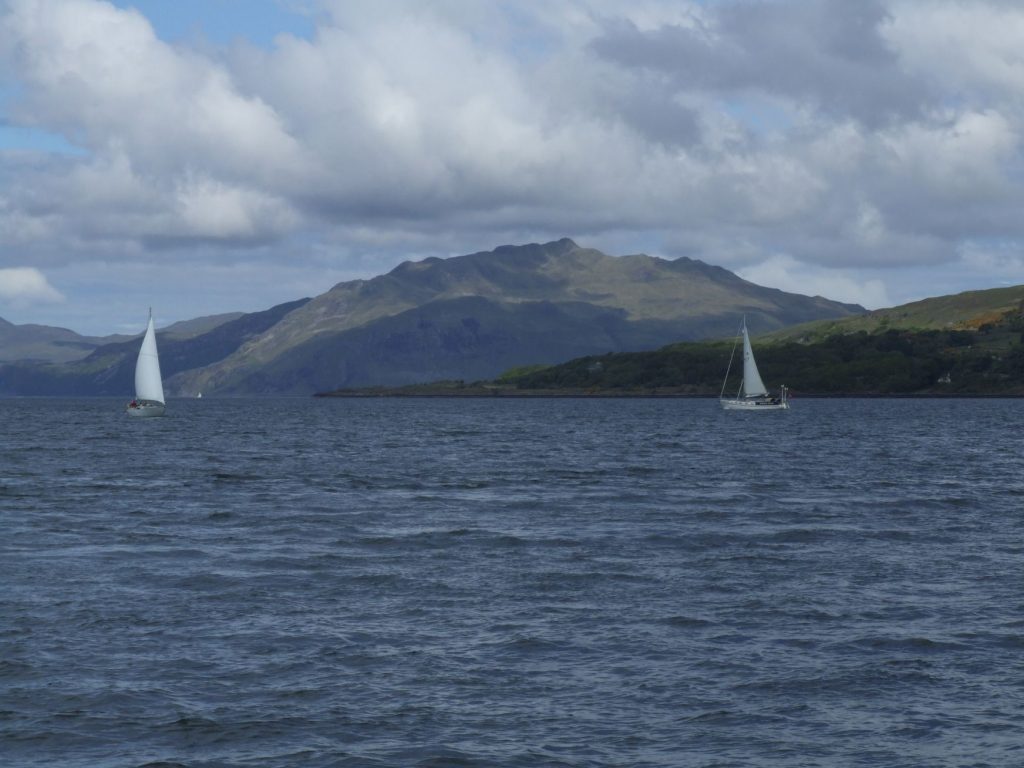
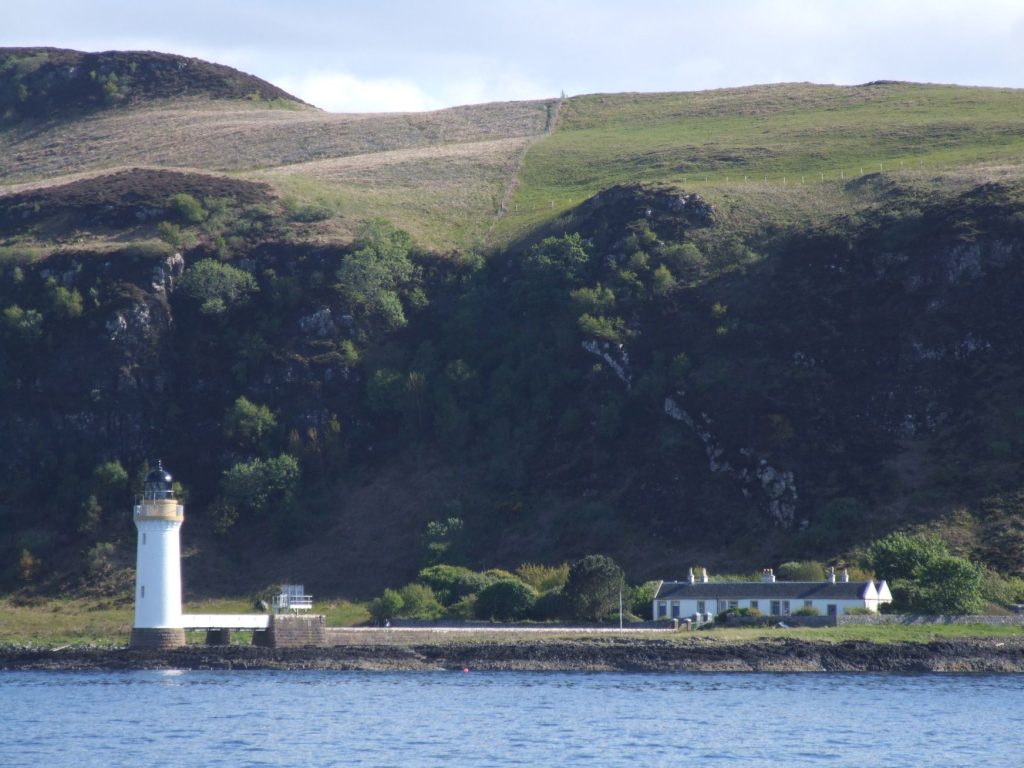
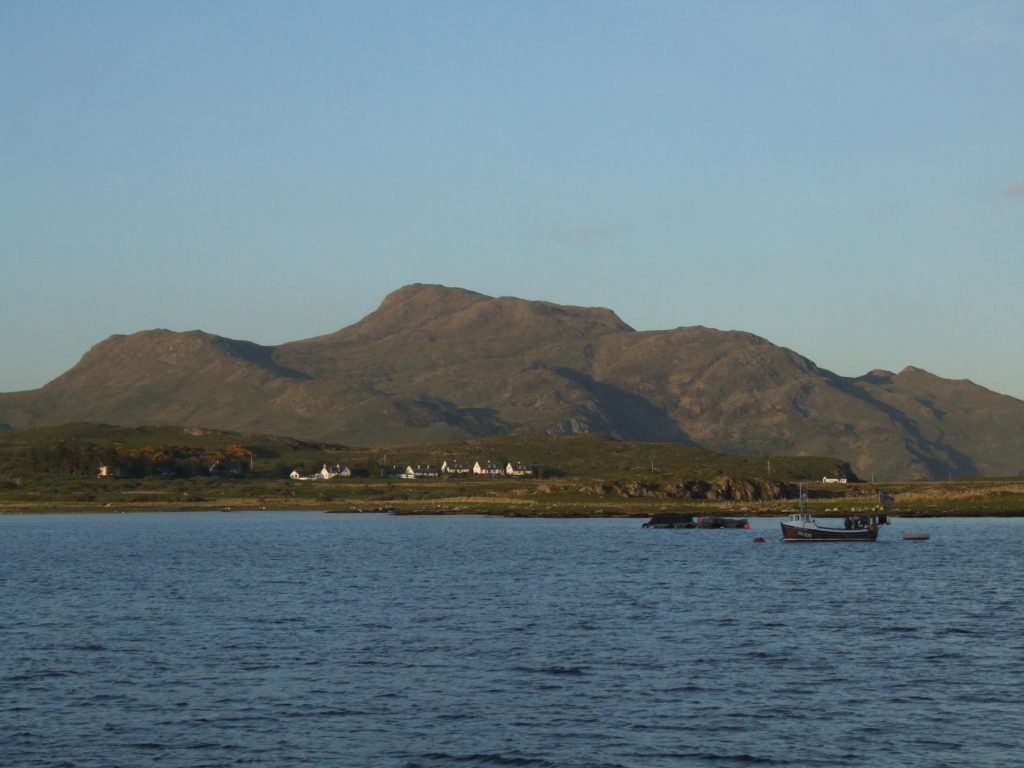
Day 3 Monday. Sailing is much nicer when you are actually sailing, so it was good to be able to sail away from the buoy in the morning without using the motor. Out and around Ardnamurchan point, seeing a basking shark on the way, then, up towards Skye, with the wind generally behind us. We didn’t have a spinnaker, but did have a pole to keep the foresail out when on a run, and that was handy. We saw a minke whale, then past Eigg and Rum in sunny weather, and up to Loch Scavaig on the south of Skye. This is a dramatic place to anchor, with the Cuillin ridge forming the backdrop. We landed, and explored in various directions. There were great views of Loch Coriusk and the Cuillins.
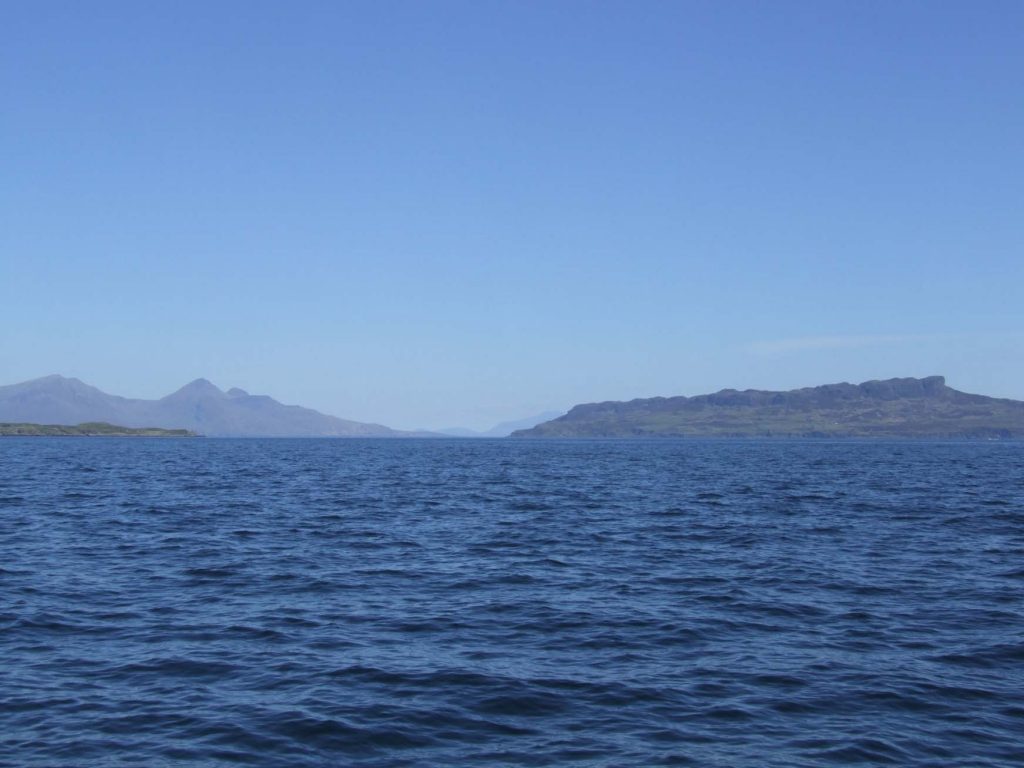
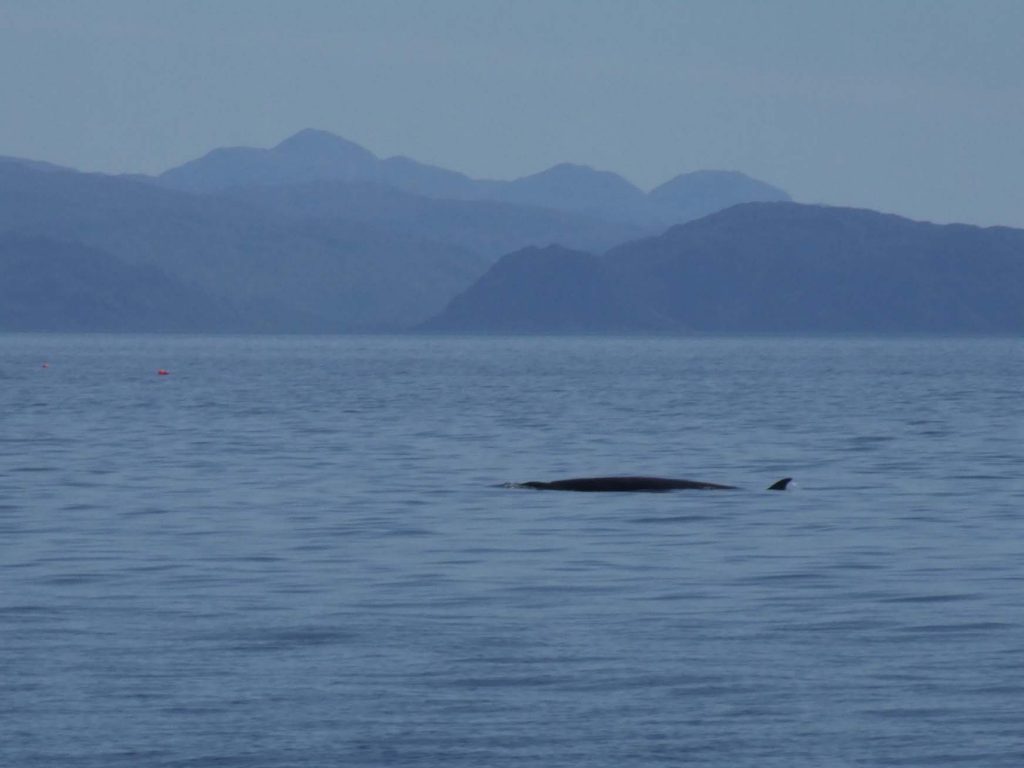

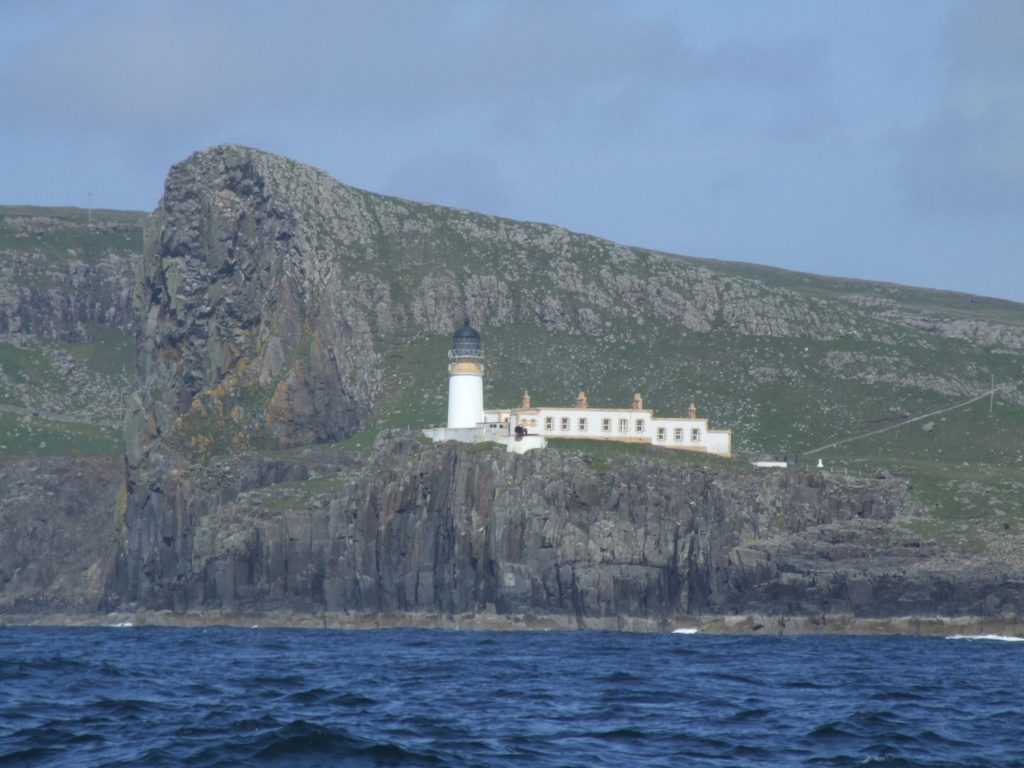
Day 4 Tuesday. A foggy start to the day, with some motoring, then running close hauled along the west coast of Skye in a north westerly. We came past Neist Point Lighthouse, which is dramatic when visited from the land, but even more so from the sea. Then into Loch Dunvegan, where we reached over 9 knots heading down the loch. We anchored at the head of the loch, with a village shop close by.
Day 5 Wednesday. Continuing north, we headed towards the Shiant Islands. The wind had shifted around to the south, and we were on a run. We tried using just the foresail. This worked fine, seemed to give us just as much speed as with the main, and no worries about accidentally gybing. The Shiant Islands are very exposed, but we found a place to anchor, and went ashore. There is abundant bird life here, with puffins, razorbills and shags all nesting in great numbers. Also a number of seals. These islands, though small, were once inhabited, and there are the remains of run-rig fields.
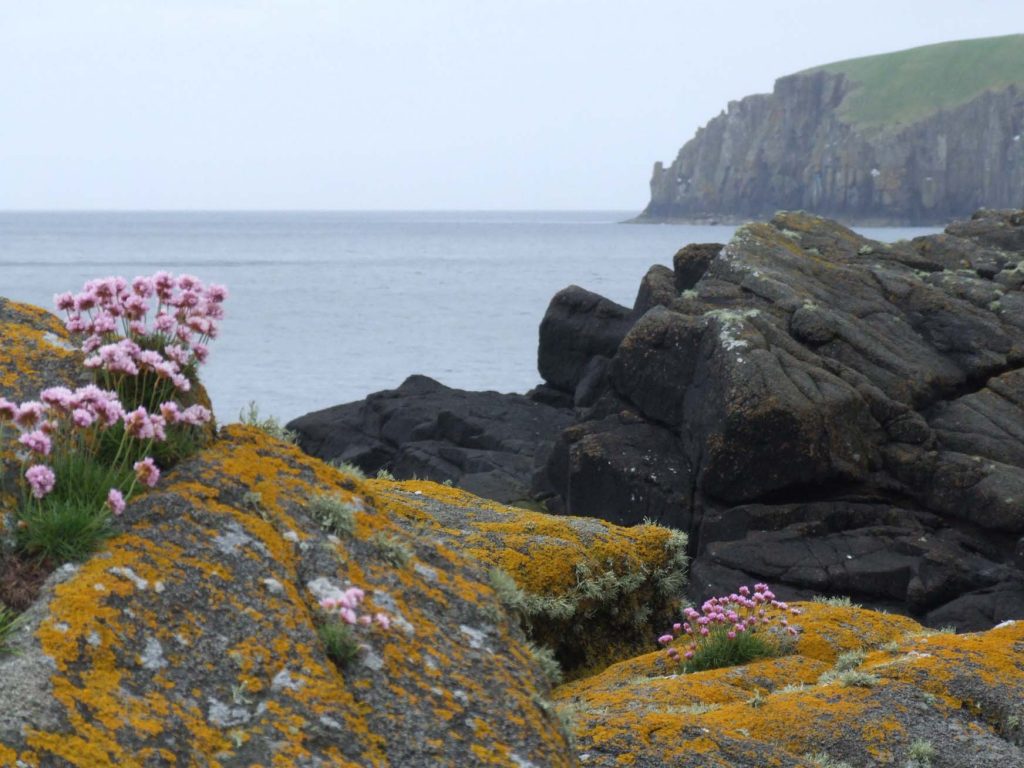
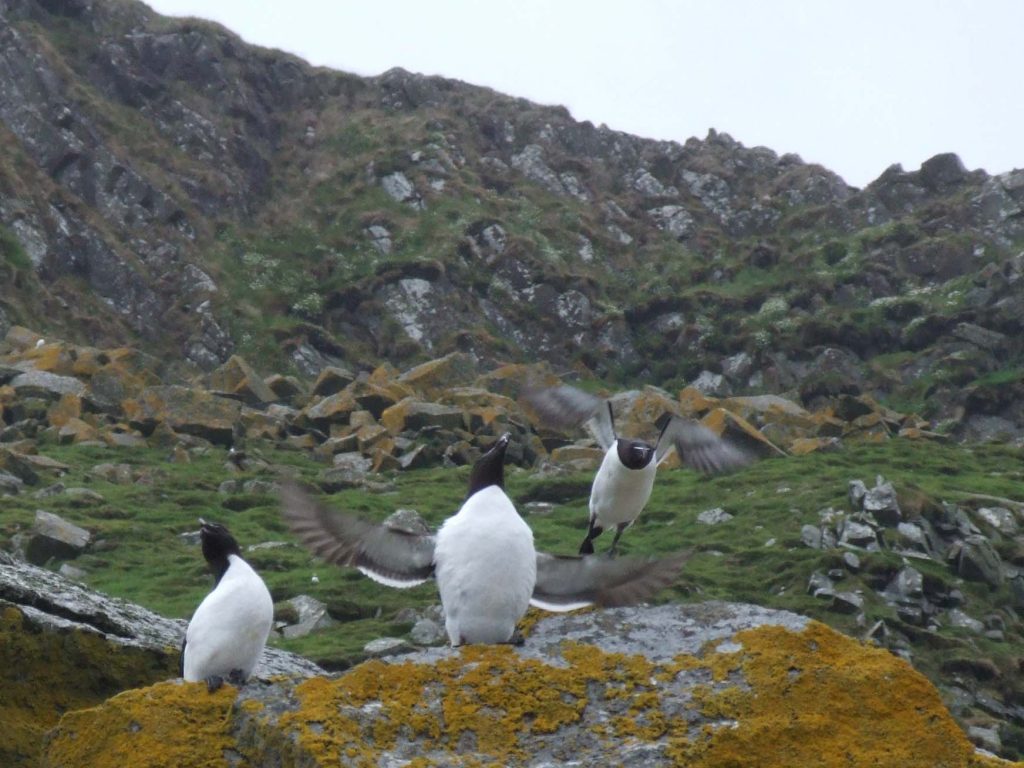
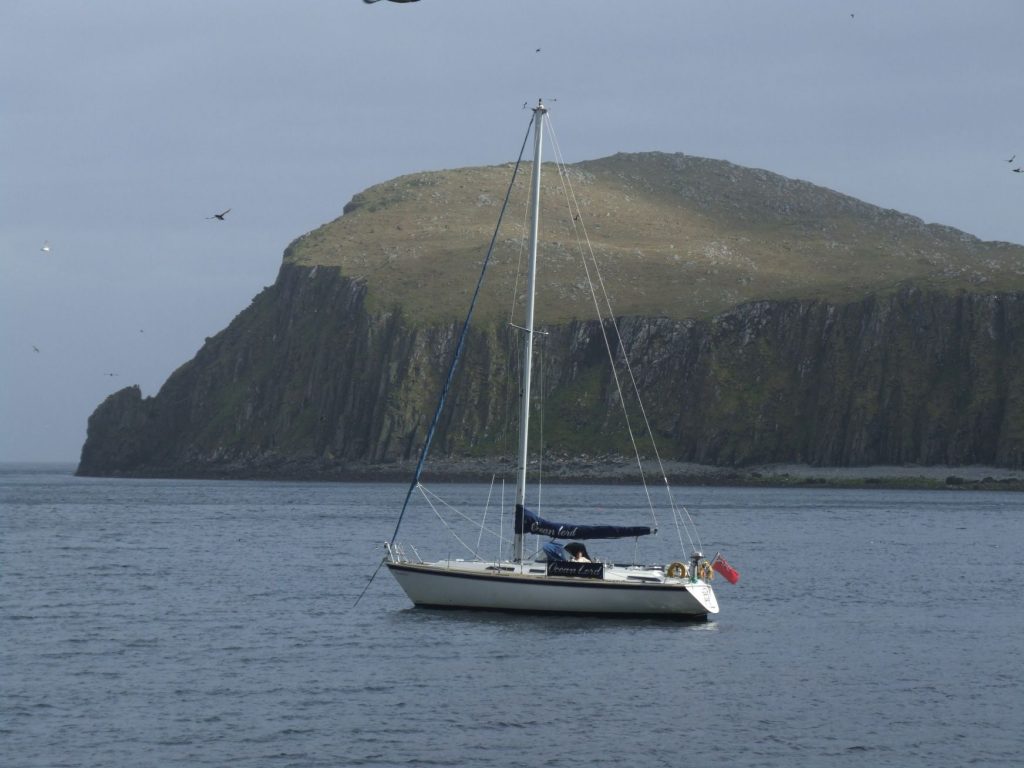
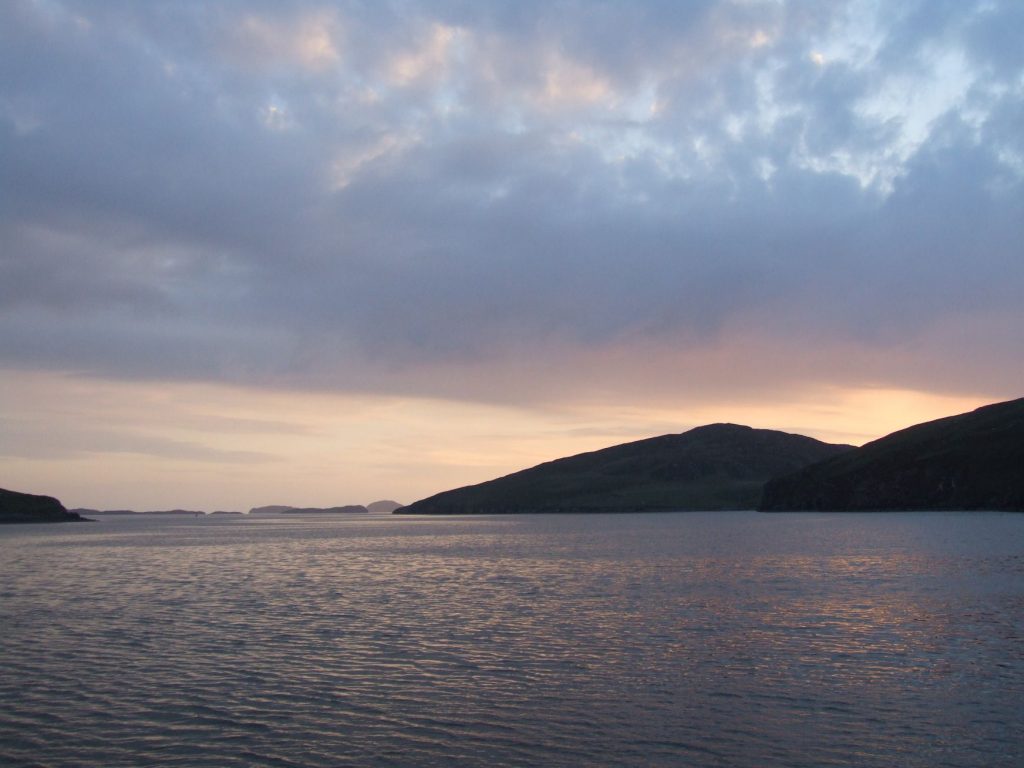
Day 6 Thursday. Fog patches as we left Shiant, then sunny, but no wind, so we were motoring most of the way to Stornoway. Culture shock on arrival, as Stornoway, though fairly remote by British standards, is a busy commercial port, and we were berthed against pilings in the harbour – the first time since we left that we could step directly onto land from the yacht. Luxury: shops, showers, laundromat, a choice of pubs…
Day 7 Friday. A long day. We needed to get around Lewis, and there was no wind, so we motored all the way around the Butt of Lewis to Loch Carlaway. A bit frustrating, because it’s nearly 60 miles by sea, but about 12 as the crow flies… We had some sharp showers during the day, but a beautiful evening. We anchored in Loch Carlaway. Until now, I have been in familiar waters. But from Stornoway, heading north, I am in new territory.
Day 8. Saturday. The big sailing day, because the next stop is St Kilda itself. First we sailed past the Flannan Islands, where three lighthouse men were lost, in mysterious circumstances, in 1900. Then we headed SW towards St Kilda. Wind initially from the NW, but backed SW, so we ended up motoring for a large part of the trip. Some dolphins appeared, but didn’t stay to play for long. Coming from the N is a great approach, because you first see Boreray and its two stacks, with gannets wheeling overhead. We sailed close to Stac Armin and then around Stac Lee, both of which have large colonies of gannets. Finally we sailed close to Boreray itself where there were lots of Puffins. We saw a gannet being attacked by a skua. Brian said that he had seen a gannet killed by three skuas on a previous trip. This one got away. Then to St Kilda itself, and into Village Bay. The bay faces SE, so everyone hopes there won’t be a swell coming in from that direction. Fortunately the wind stayed in the SW, so we had reasonable shelter for anchoring. We stayed there two nights.
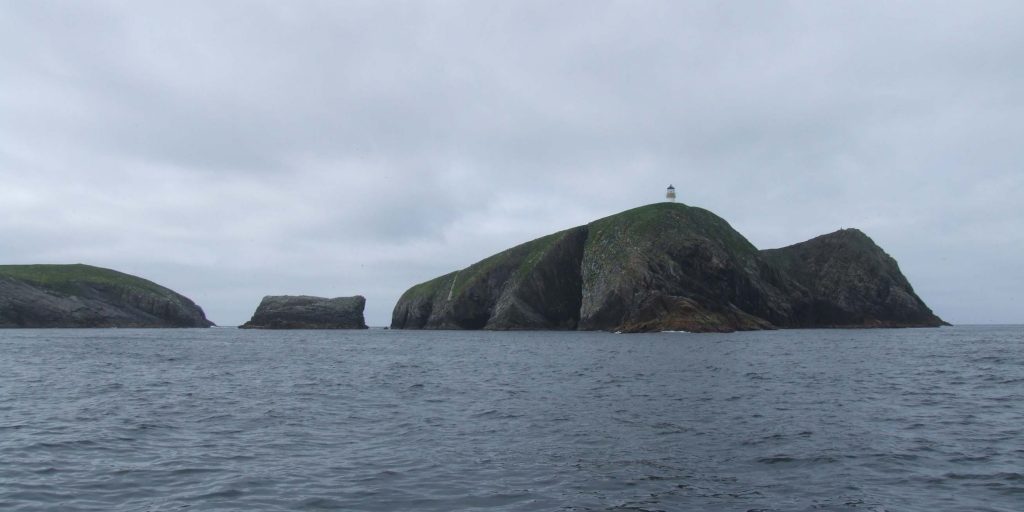
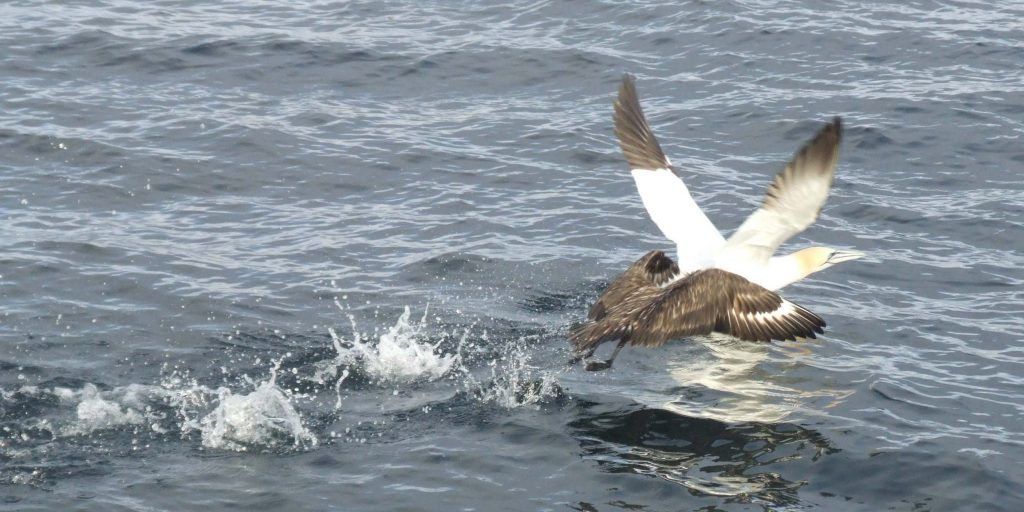
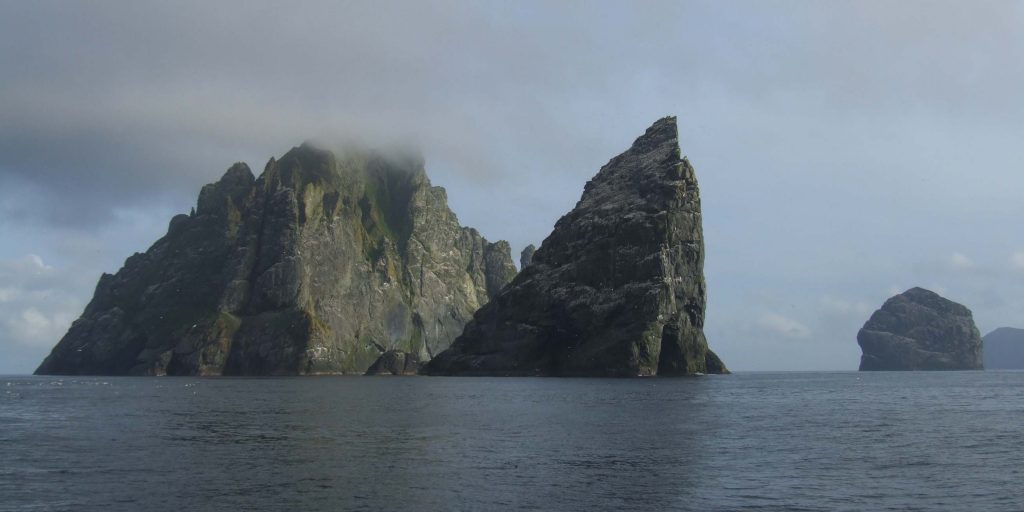
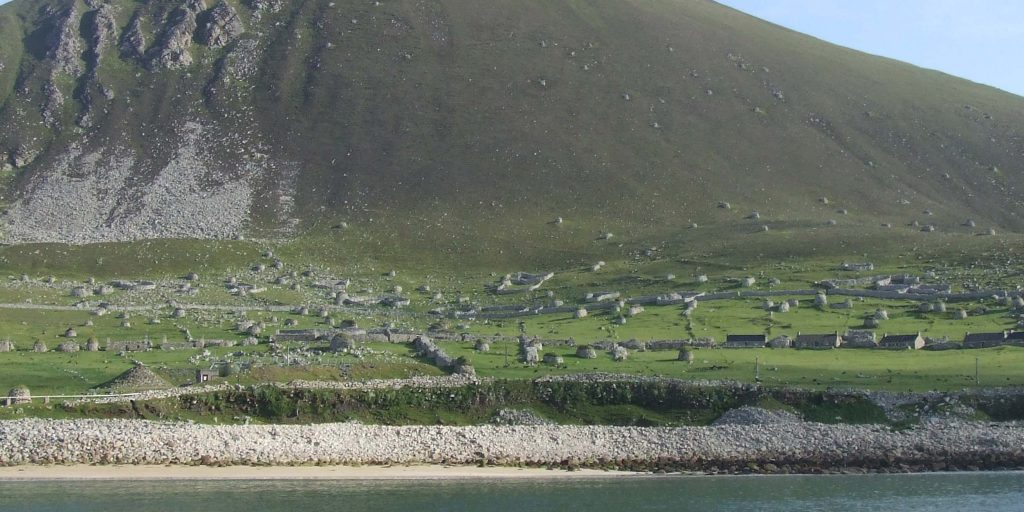
Day 9 Sunday. A day on St Kilda. First to the village, no longer uninhabited, as the National Trust has volunteers staying here during the summer, and the army still has a presence. A mixture of the ruined “black houses”, with turf roofs and no chimneys, and the more modern houses that replaced them in the mid C19, some of which have been restored. And everywhere the cleits, the drystane, turf thatched storage structures that are found all over the island, and even perched on cliffs.
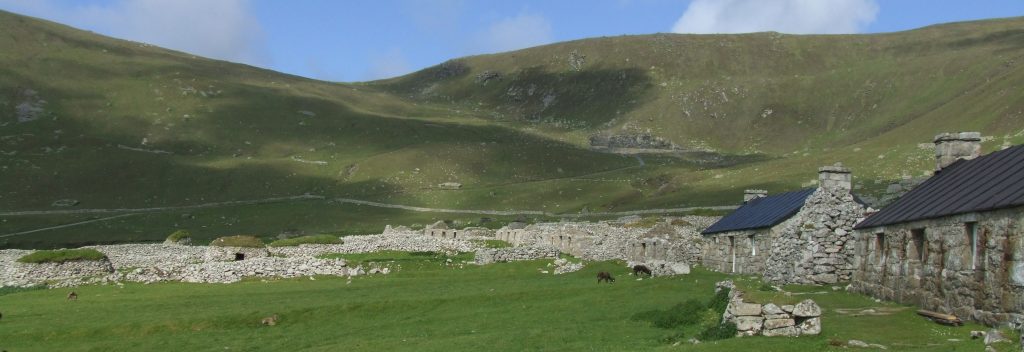
St Kilda is a sad place, the life here was so hard, and the way of life probably doomed as soon as regular contact was established with the outside world in the mid C19. Tourism and the influence of the kirk didn’t help, but probably the only way that people can endure such a lonely and arduous existence is not to know that there is an alternative.
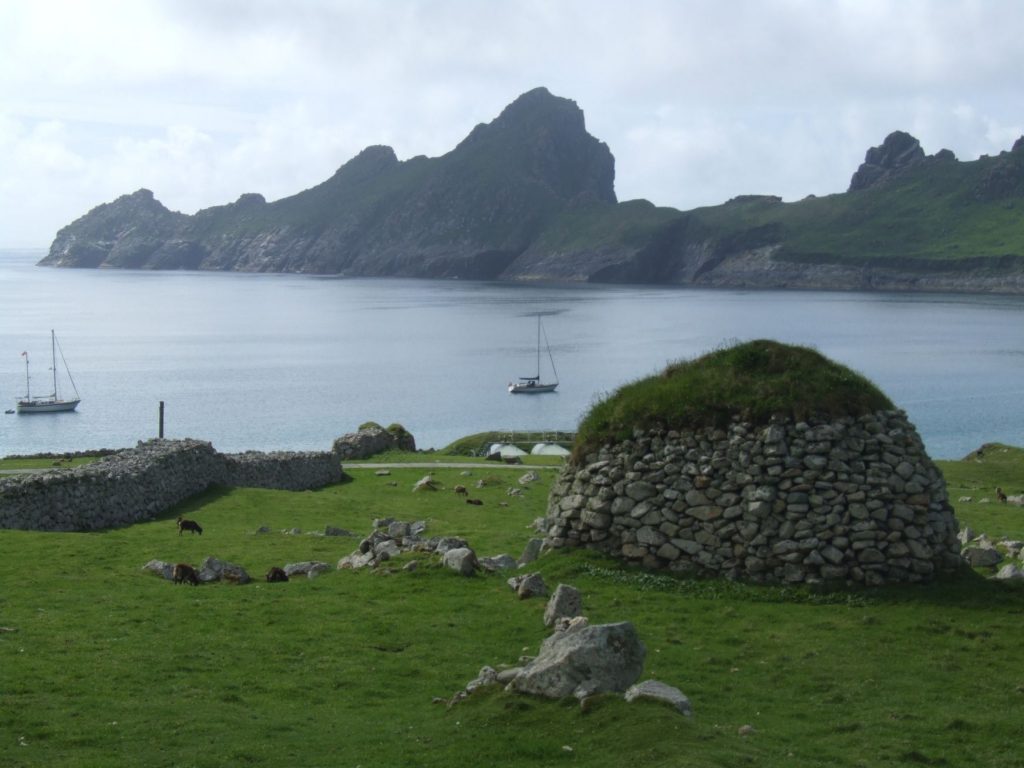
But the islands themselves, though tiny, are dramatic and beautiful. St Kilda has the highest sea cliffs in Britain, rising to nearly 1000 ft in the North. The highest point on the islands is only about 1300 ft! The bird life is abundant – fulmars, skuas, puffins, gannets – and of course this was the mainstay of the islanders existence. The lamps of the island were lit with fulmar oil – there is 0.25 litre of oil in each adult bird. The birds and their eggs were the main source of food, though there were also sheep, and as run-rig fields again testify, at least some growing of crops.
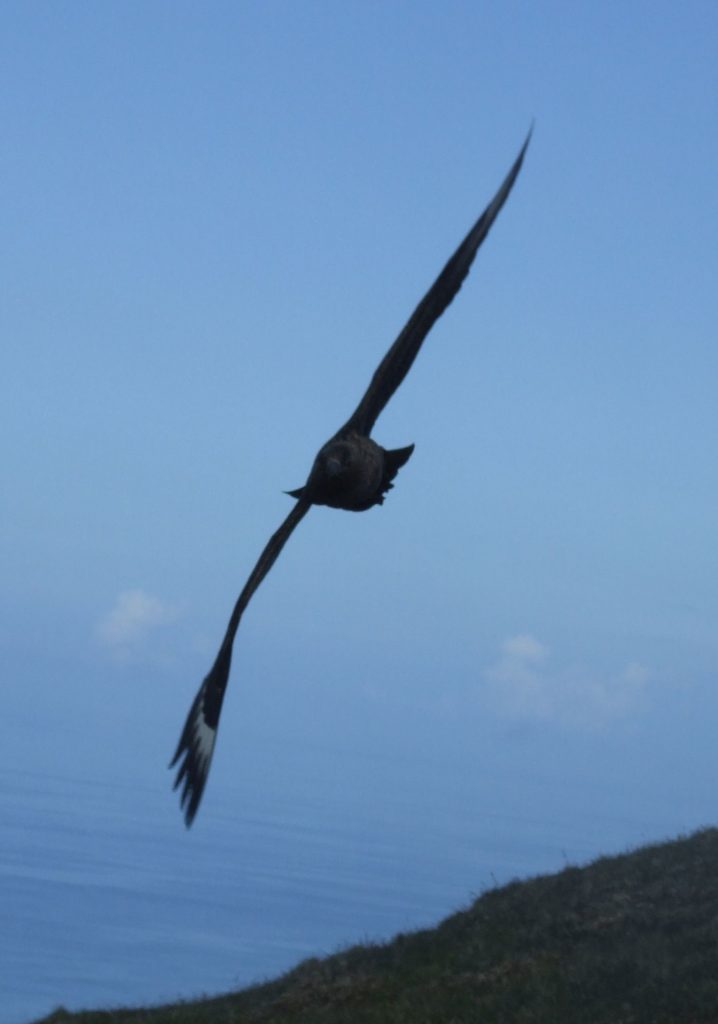
I walked from one end of the main island (Hirta) to the other. That isn’t hard, it’s less than 3 miles long. On the way I got to know skuas more intimately than I might have wished – they dive bomb you if you get too close to their nests, and as there are a lot of them, and they nest on the moorland, not the cliffs, this is hard to avoid. But I got some good photos, and skuas are interested in each other as well as in intruders…
St Kilda is a remote spot, but it is becoming more popular as a destination. The second night we were there, there were six yachts anchored in the bay.

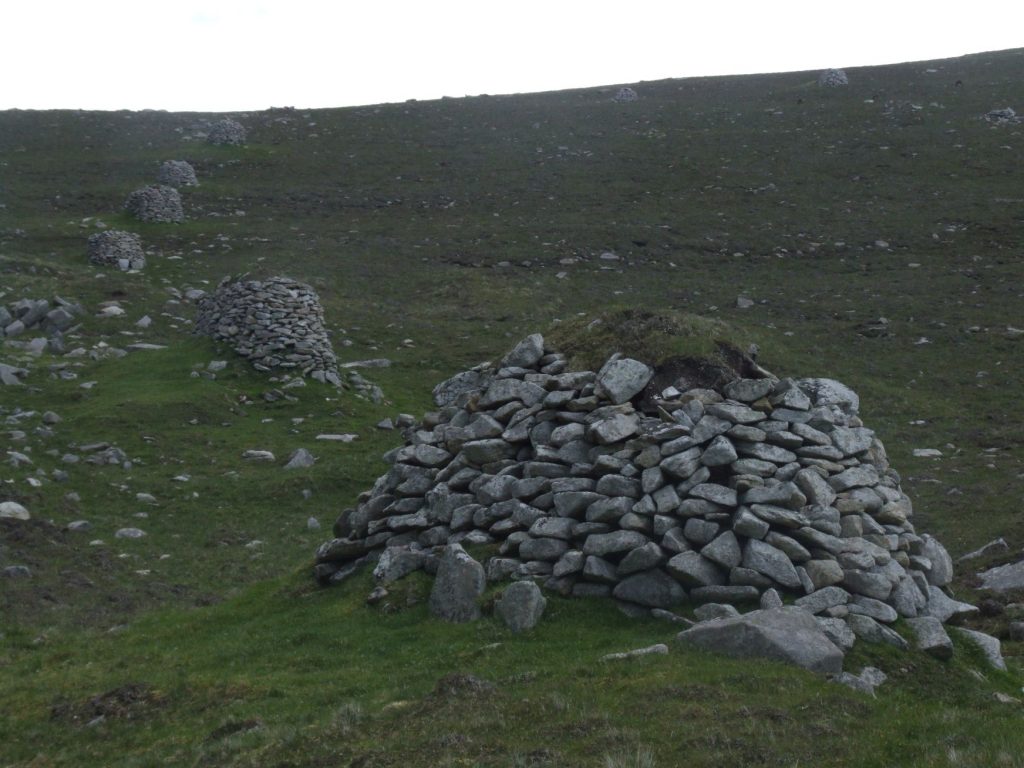
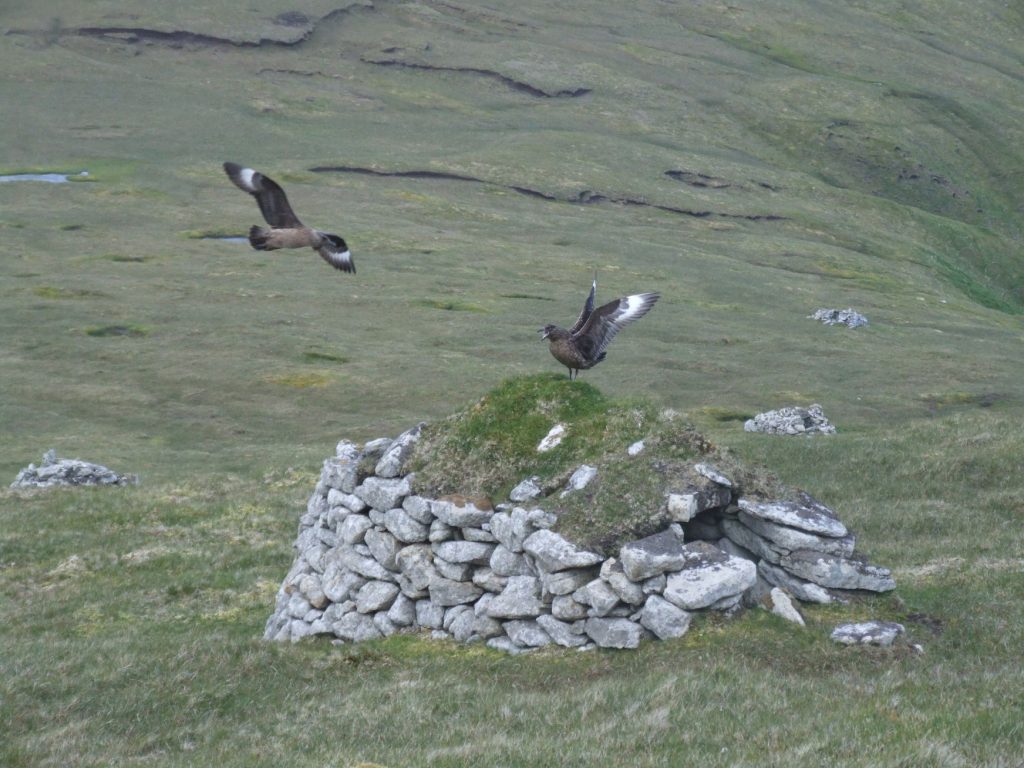
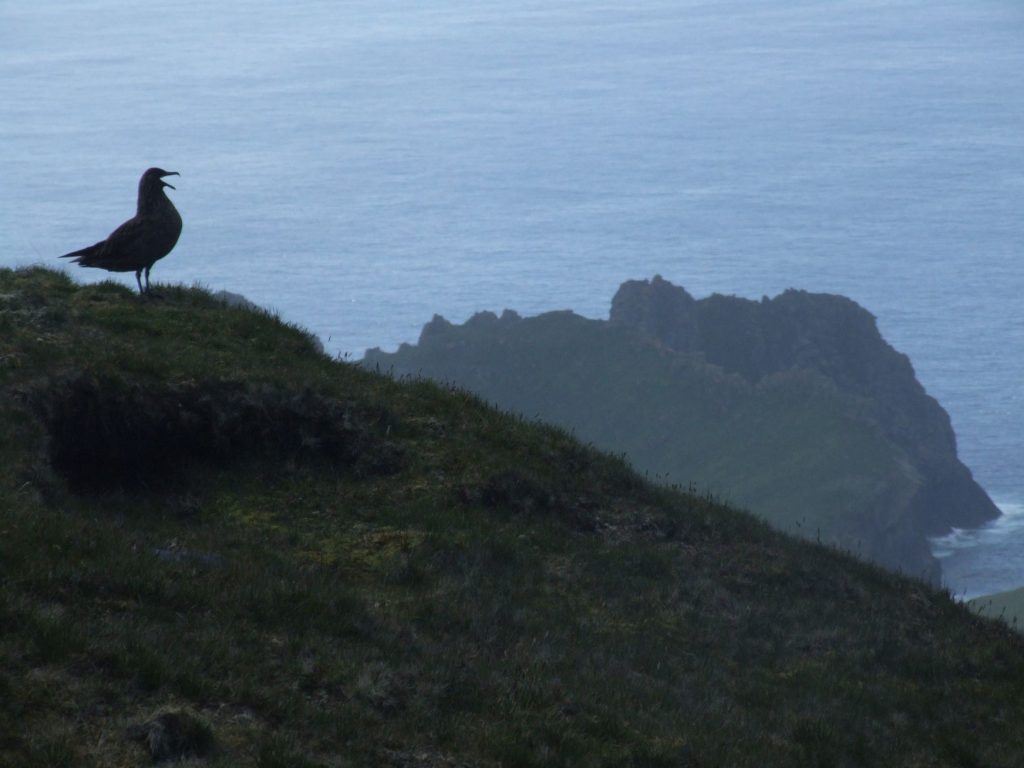
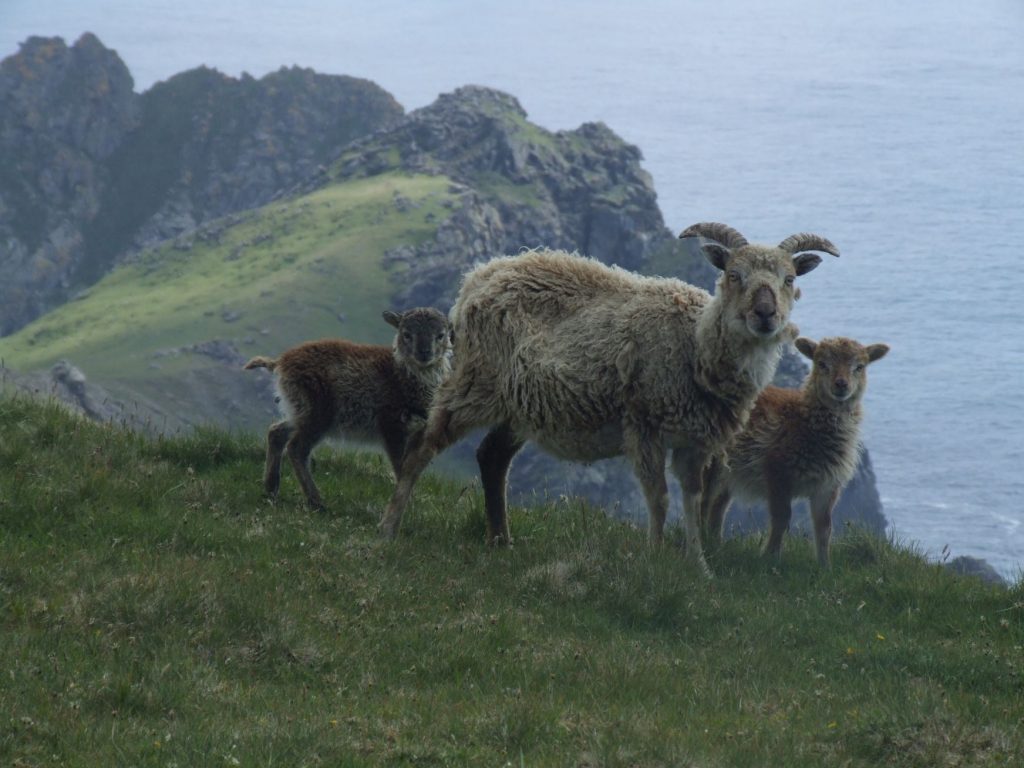
Day 10 Monday. We left Village Bay, and first did a complete clockwise circuit of Hirta. We saw some of the peaks that we climbed yesterday, and went between Hirta and Soay through a narrow channel with stacks, one with an arch. Then we sailed past the highest sea cliffs in Britain on the north face of Hirta, then headed SE towards the Monach Isles. A fine sail, with a steady north easterly.
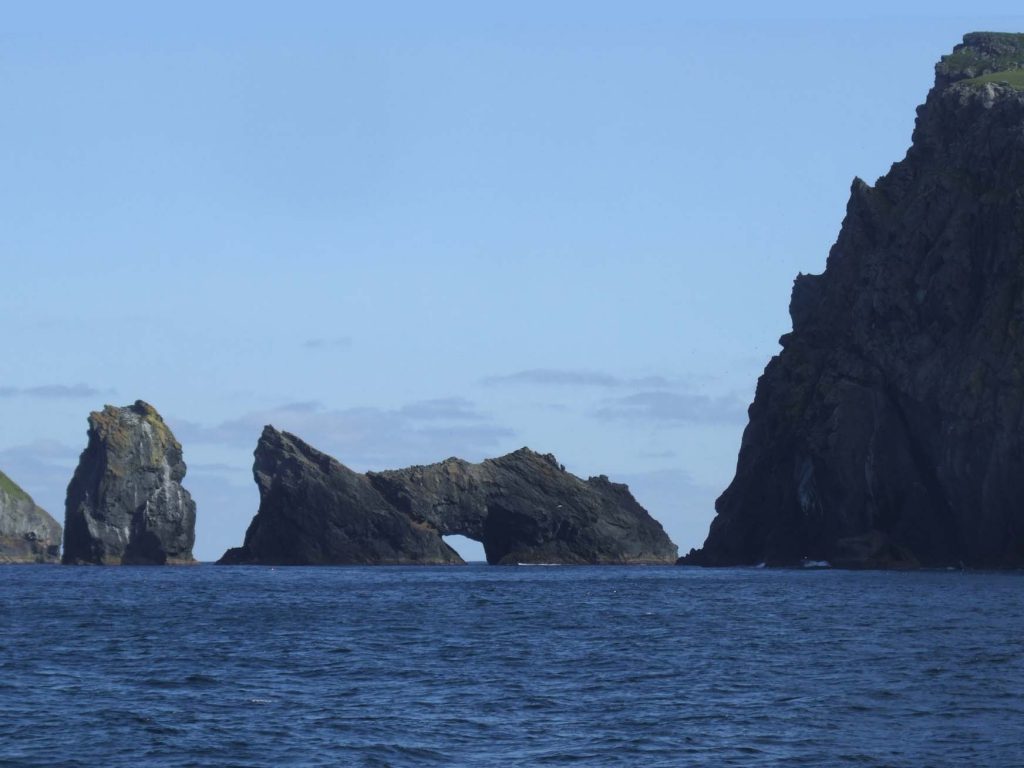
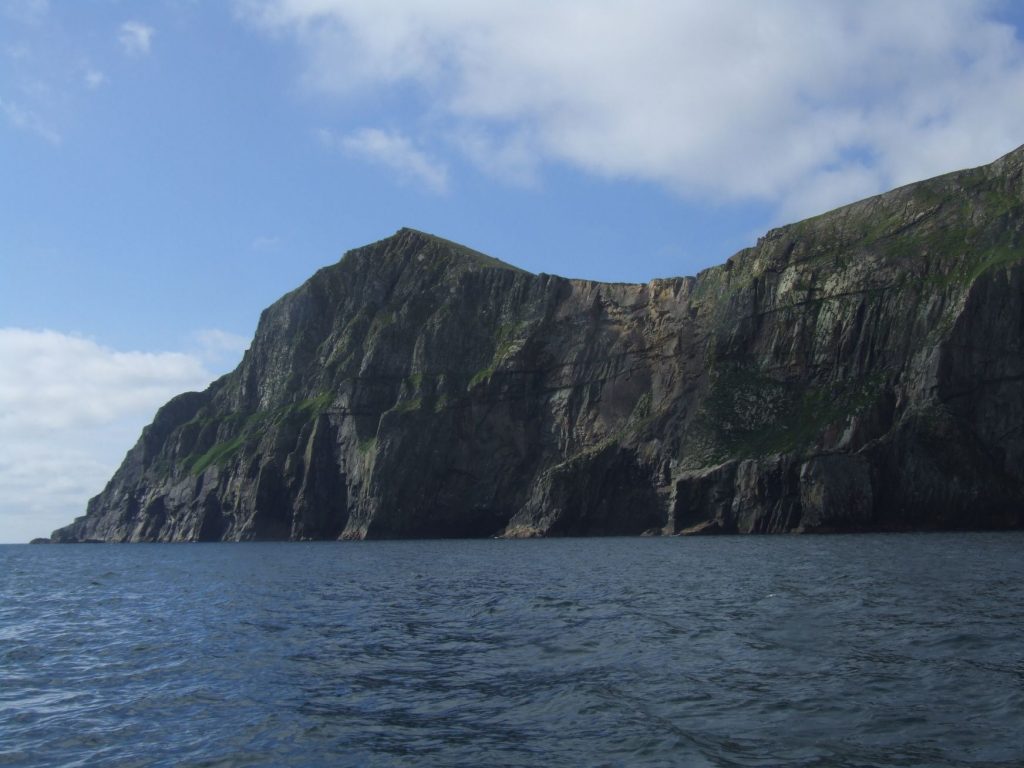
The Monach Isles are a complete contrast to St Kilda. Basically little more than a strip of sand dunes off N Uist, the highest point is 19m above sea level. We anchored in a channel between two of the islands, with a drying spit between us and the prevailing NE, which gave us shelter from the swell, but none at all from the wind. Pretty exposed, in fact, but it did the job, and we got to spend some time on another isolated island that had once been inhabited. This is machair, the meadow full of flowers that forms on salty sand dunes all along the Atlantic coast of the outer Hebrides. And lovely sandy beaches, totally deserted of course. The only signs of human life were the lighthouse, a few ruined buildings, and a lobster boat offshore. Later another boat anchored near to us.

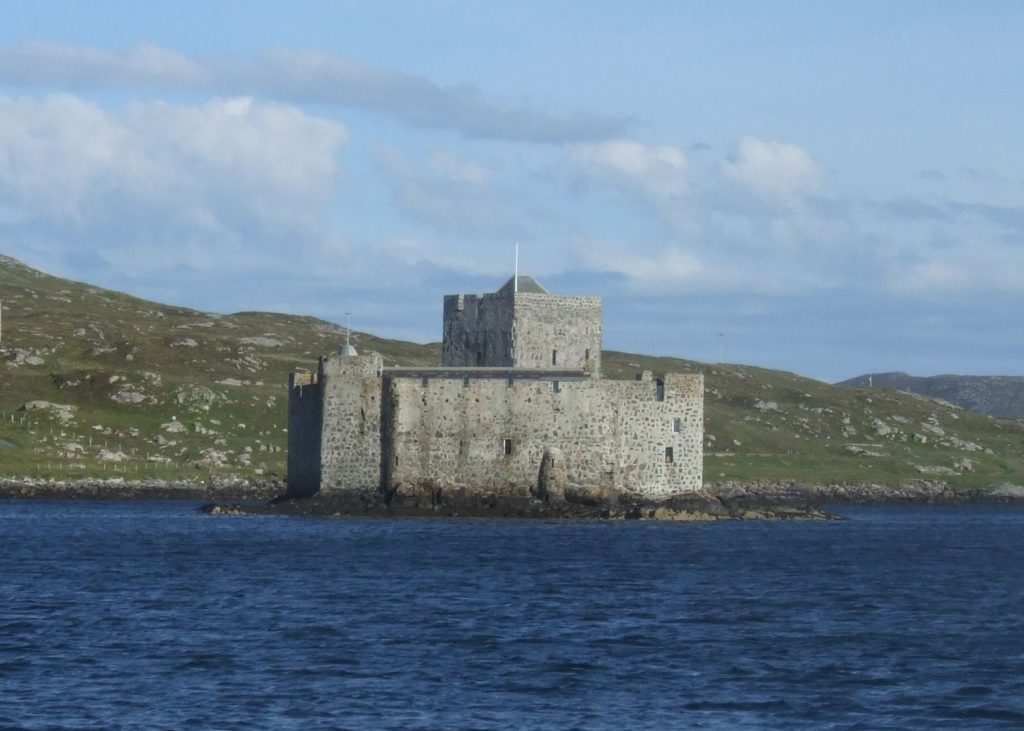
Day 11 Tuesday. From the Monachs we headed south, then through Barra Sound, and around to Castlebay at the south end of Barra. The NE winds continued, and we had another fine day’s sailing. Here we were on a mooring again, but Castlebay is a town, though a small one, and we were again able to get showers, hit the shops, and find a meal on shore. Much to our surprise we got a really excellent Indian meal (with Barra Lamb!) at a cafe close to the harbour. Castlebay is aptly named – the castle is on a tiny island in the harbour. A very attractive spot.

Day 12 Wednesday. From Barra, SE again towards Coll. The wind had veered towards the east, but still good sailing. We passed between Coll and Tiree, then round into Loch Breachaha, on the south of Coll. Anchored here for dinner, then set off again on a bit of night sailing (as much as you can do in June in Scotland!). We headed out, spent some time recognizing and taking bearings on the numerous lights in sight, from Skerryvore to Ardnamurchan, then came into Arinagour to finally anchor for the rest of the night.
Day 13 Thursday. We headed past the Treshnish Isles towards Mull. I’m now back in familiar waters. We spent some time practicing man overboard in light northerly winds, then anchored for lunch between Ulva and Gometra. Then south, to Staffa. I’ve sailed past Staffa several times, and always wanted to go ashore, but this was the first time. We took the dinghy in to the landing place, and I went first to the summit of the Island, with a wonderful 360 degree panorama, then into Fingal’s Cave, dark, mysterious and equally wonderful. Brian and Phil were off doing some more man overboard practice, then nosed the yacht almost up to the mouth of the cave, as if to see whether the mast would fit inside (it wouldn’t). Then we headed south, through the channel between Iona and Mull, around the south of Mull, to White Beach, where we anchored for the night.

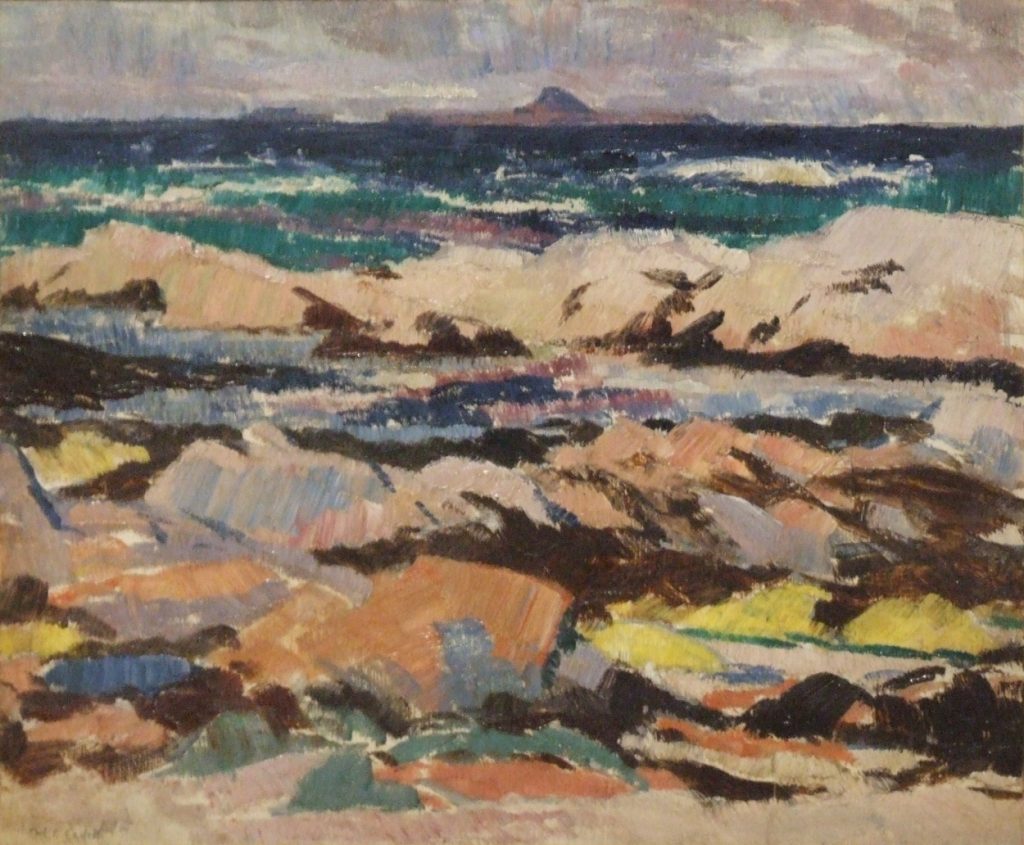
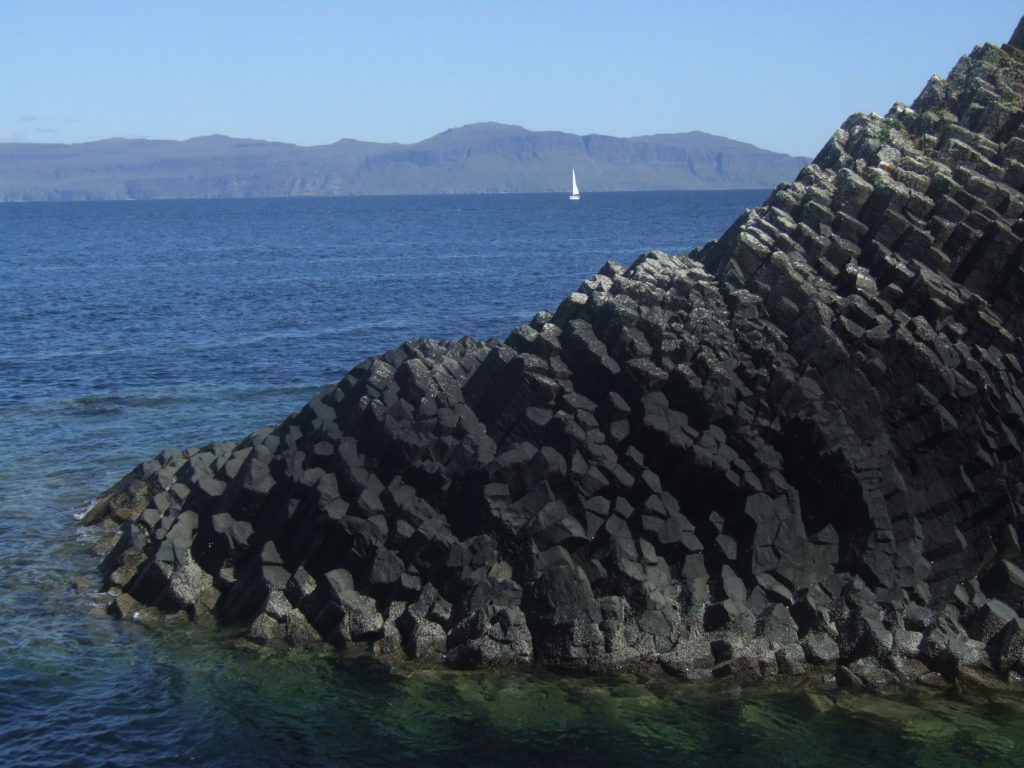
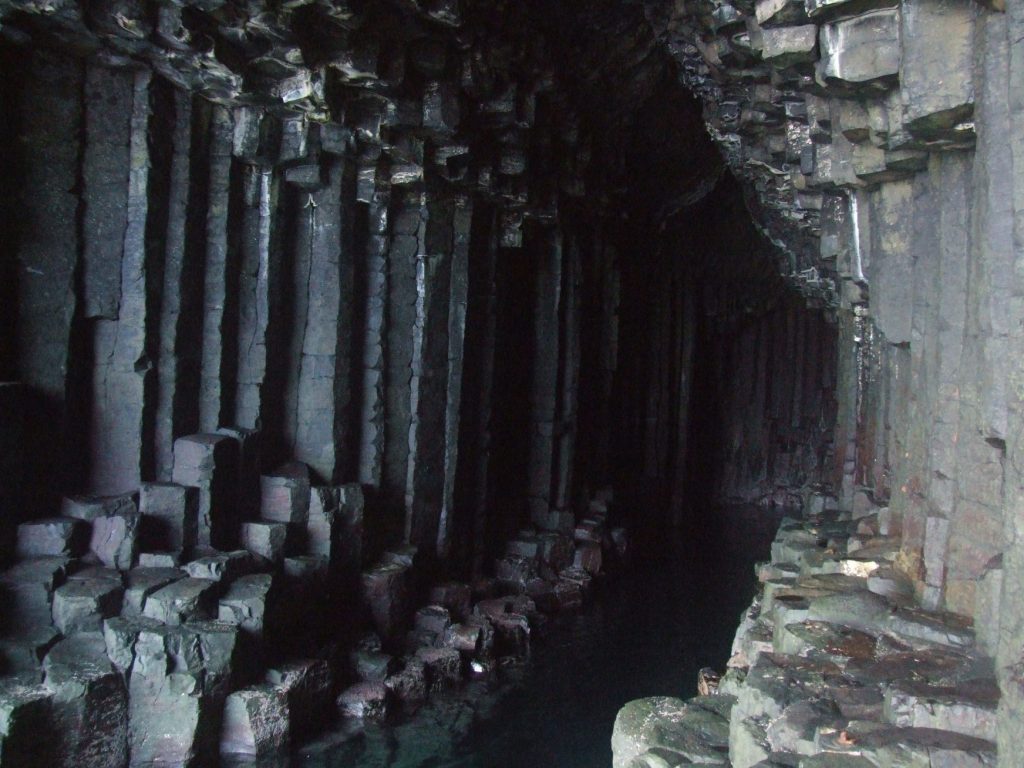
Day 14 Friday. Mist and drizzle in the morning. We needed a bit of motor, the first time we’ve used the engine, except when anchoring or mooring, since we left St Kilda. Then the wind picked up, and we headed up the Firth of Lorne to the Garvelachs. We anchored on the southern island Eiliach an Naoimh and went ashore to explore the remains of the ancient monastery there. Great views across the firth to Easdale. Then on up the Firth. Crazy winds, sometimes going around in circles. Once past the Garvelachs the winds got a bit more predictable, from the NW, but quite a lot stronger, gusting to force 6, and we now did some more man overboard practice. Fair enough, you can’t choose when a real person will fall off, but it was quite an experience. We then sailed on up the Lynn of Lorne, back to the base at Dunstaffnage, and civilisation. We drove into Oban to get Fish and Chips!
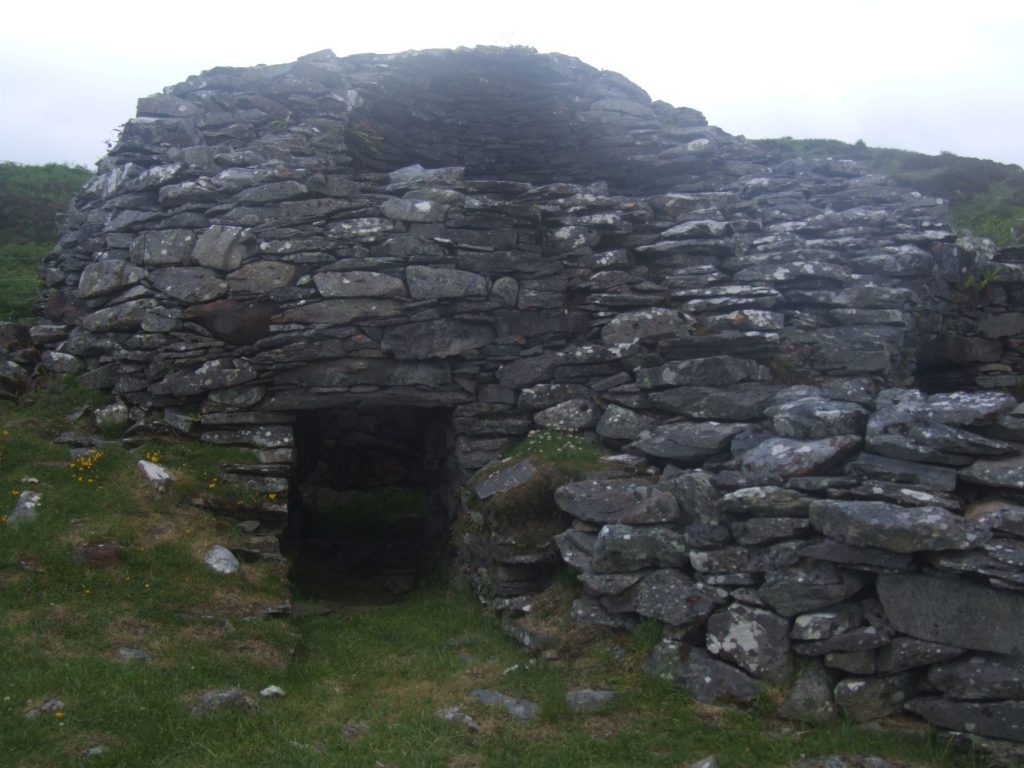
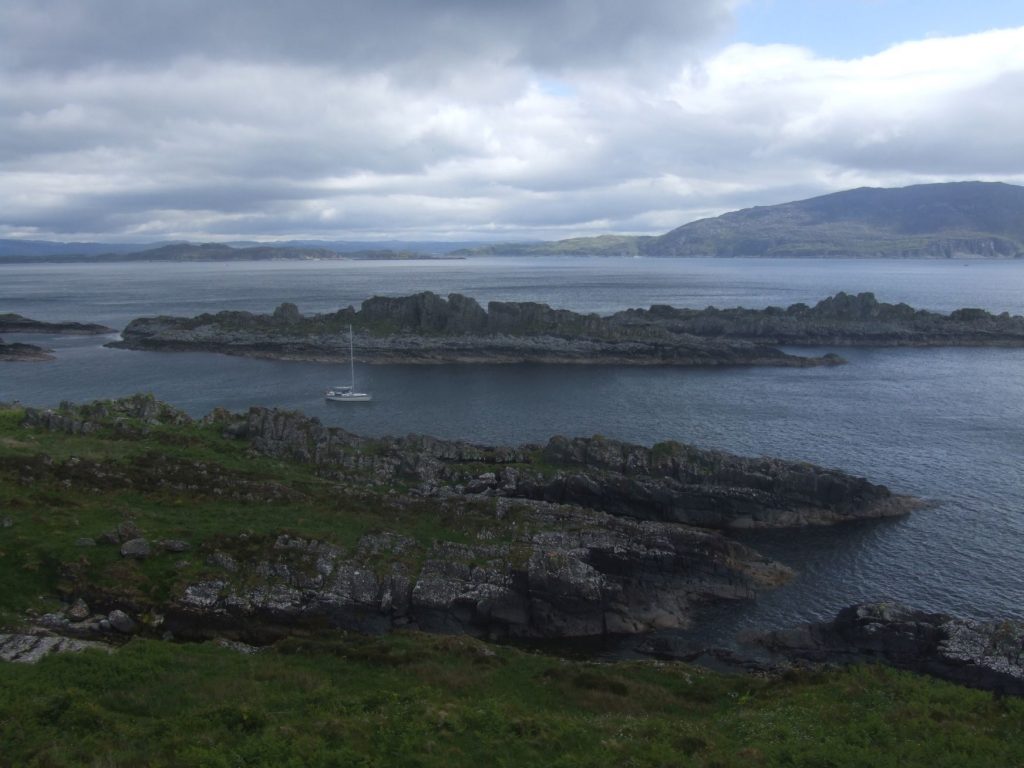
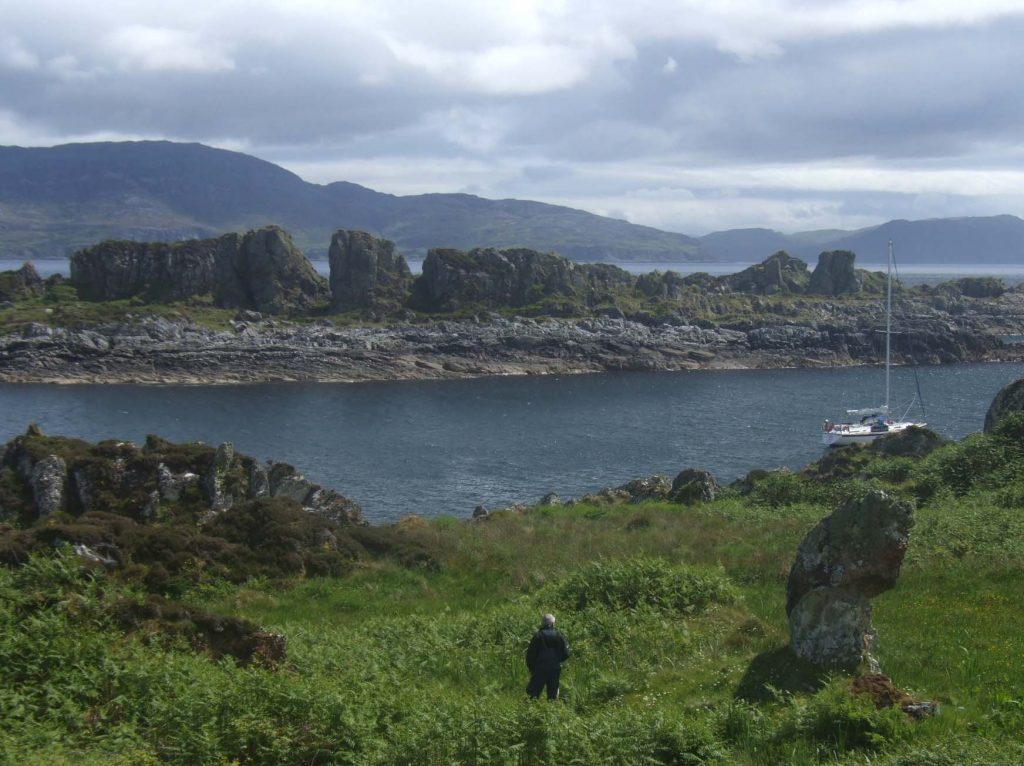
Day 15 Saturday. Signing of certificates and logs, cleaning the boat, finding out where the buses back to Glasgow are running, following the train crash, which has blocked the road at Cruachan, and other mundane practical things. And fond farewells. This has been a memorable trip!